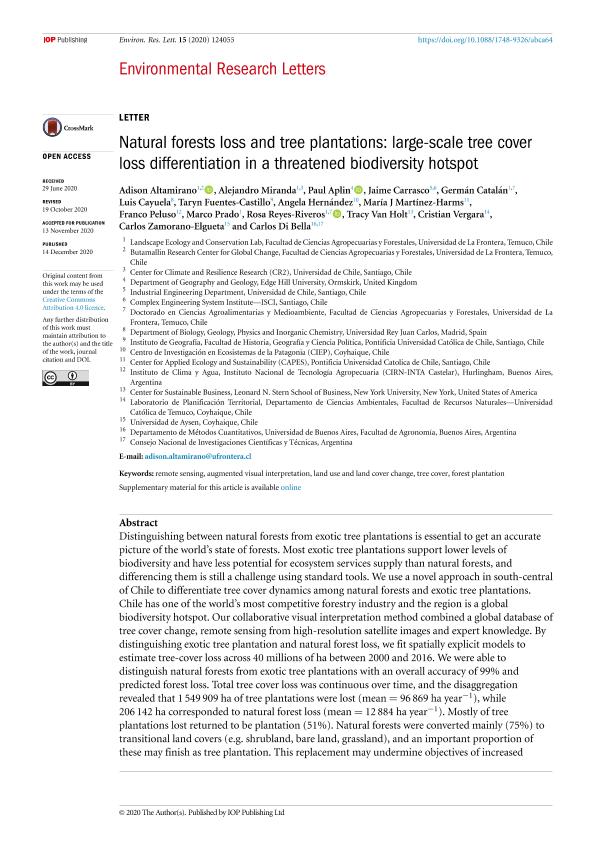Artículo
Natural forests loss and tree plantations: Large-scale tree cover loss differentiation in a threatened biodiversity hotspot
Altamirano, Adison; Miranda, Alejandro; Aplin, Paul; Carrasco, Jaime; Catalán, Germán; Cayuela, Luis; Fuentes Castillo, Taryn; Hernández, Angela; Martínez Harms, María J.; Peluso, Franco; Prado, Marco; Reyes Riveros, Rosa; Van Holt, Tracy; Vergara, Cristian; Zamorano Elgueta, Carlos; Di Bella, Carlos Marcelo

Fecha de publicación:
14/12/2019
Editorial:
IOP Publishing
Revista:
Environmental Research Letters
ISSN:
1748-9326
e-ISSN:
1748-9326
Idioma:
Inglés
Tipo de recurso:
Artículo publicado
Clasificación temática:
Resumen
Distinguishing between natural forests from exotic tree plantations is essential to get an accurate picture of the world's state of forests. Most exotic tree plantations support lower levels of biodiversity and have less potential for ecosystem services supply than natural forests, and differencing them is still a challenge using standard tools. We use a novel approach in south-central of Chile to differentiate tree cover dynamics among natural forests and exotic tree plantations. Chile has one of the world's most competitive forestry industry and the region is a global biodiversity hotspot. Our collaborative visual interpretation method combined a global database of tree cover change, remote sensing from high-resolution satellite images and expert knowledge. By distinguishing exotic tree plantation and natural forest loss, we fit spatially explicit models to estimate tree-cover loss across 40 millions of ha between 2000 and 2016. We were able to distinguish natural forests from exotic tree plantations with an overall accuracy of 99% and predicted forest loss. Total tree cover loss was continuous over time, and the disaggregation revealed that 1 549 909 ha of tree plantations were lost (mean = 96 869 ha year-1), while 206 142 ha corresponded to natural forest loss (mean = 12 884 ha year-1). Mostly of tree plantations lost returned to be plantation (51%). Natural forests were converted mainly (75%) to transitional land covers (e.g. shrubland, bare land, grassland), and an important proportion of these may finish as tree plantation. This replacement may undermine objectives of increasedcarbon storage and biodiversity. Tree planting as a solution has gained increased attention in recen years with ambitious commitments to mitigate the effects of climate change. However, negative outcomes for the environment could result if strategies incentivize the replacement of natural forests into other land covers. Initiatives to reduce carbon emissions should encourage differentiating natural forests from exotic tree plantations and pay more attention on protecting and managing sustainably the former.
Archivos asociados
Licencia
Identificadores
Colecciones
Articulos(SEDE CENTRAL)
Articulos de SEDE CENTRAL
Articulos de SEDE CENTRAL
Citación
Altamirano, Adison; Miranda, Alejandro; Aplin, Paul; Carrasco, Jaime; Catalán, Germán; et al.; Natural forests loss and tree plantations: Large-scale tree cover loss differentiation in a threatened biodiversity hotspot; IOP Publishing; Environmental Research Letters; 15; 12; 14-12-2019; 1-10
Compartir
Altmétricas



